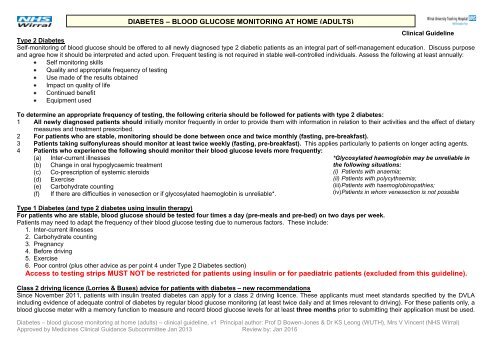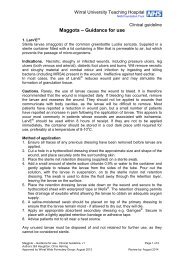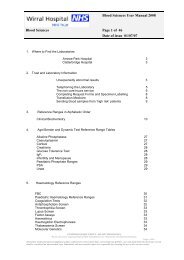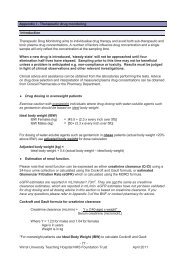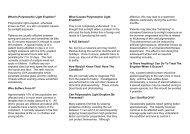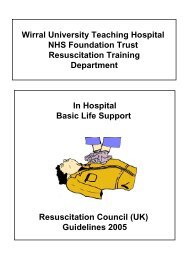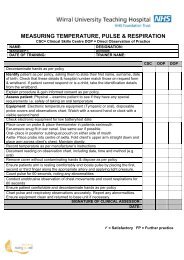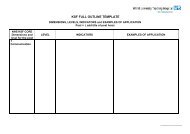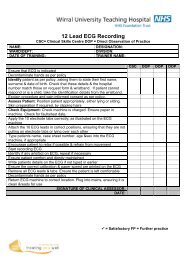Blood glucose monitoring at home (adults)
Blood glucose monitoring at home (adults)
Blood glucose monitoring at home (adults)
You also want an ePaper? Increase the reach of your titles
YUMPU automatically turns print PDFs into web optimized ePapers that Google loves.
DIABETES – BLOOD GLUCOSE MONITORING AT HOME (ADULTS)<br />
Clinical Guideline<br />
Type 2 Diabetes<br />
Self-<strong>monitoring</strong> of blood <strong>glucose</strong> should be offered to all newly diagnosed type 2 diabetic p<strong>at</strong>ients as an integral part of self-management educ<strong>at</strong>ion. Discuss purpose<br />
and agree how it should be interpreted and acted upon. Frequent testing is not required in stable well-controlled individuals. Assess the following <strong>at</strong> least annually:<br />
Self <strong>monitoring</strong> skills<br />
Quality and appropri<strong>at</strong>e frequency of testing<br />
Use made of the results obtained<br />
Impact on quality of life<br />
Continued benefit<br />
Equipment used<br />
To determine an appropri<strong>at</strong>e frequency of testing, the following criteria should be followed for p<strong>at</strong>ients with type 2 diabetes:<br />
1 All newly diagnosed p<strong>at</strong>ients should initially monitor frequently in order to provide them with inform<strong>at</strong>ion in rel<strong>at</strong>ion to their activities and the effect of dietary<br />
measures and tre<strong>at</strong>ment prescribed.<br />
2 For p<strong>at</strong>ients who are stable, <strong>monitoring</strong> should be done between once and twice monthly (fasting, pre-breakfast).<br />
3 P<strong>at</strong>ients taking sulfonylureas should monitor <strong>at</strong> least twice weekly (fasting, pre-breakfast). This applies particularly to p<strong>at</strong>ients on longer acting agents.<br />
4 P<strong>at</strong>ients who experience the following should monitor their blood <strong>glucose</strong> levels more frequently:<br />
(a) Inter-current illnesses<br />
*Glycosyl<strong>at</strong>ed haemoglobin may be unreliable in<br />
(b) Change in oral hypoglycaemic tre<strong>at</strong>ment<br />
the following situ<strong>at</strong>ions:<br />
(c) Co-prescription of systemic steroids<br />
(i) P<strong>at</strong>ients with anaemia;<br />
(d) Exercise<br />
(ii) P<strong>at</strong>ients with polycythaemia;<br />
(e) Carbohydr<strong>at</strong>e counting<br />
(iii) P<strong>at</strong>ients with haemoglobinop<strong>at</strong>hies;<br />
(f) If there are difficulties in venesection or if glycosyl<strong>at</strong>ed haemoglobin is unreliable*.<br />
(iv) P<strong>at</strong>ients in whom venesection is not possible<br />
Type 1 Diabetes (and type 2 diabetes using insulin therapy)<br />
For p<strong>at</strong>ients who are stable, blood <strong>glucose</strong> should be tested four times a day (pre-meals and pre-bed) on two days per week.<br />
P<strong>at</strong>ients may need to adapt the frequency of their blood <strong>glucose</strong> testing due to numerous factors. These include:<br />
1. Inter-current illnesses<br />
2. Carbohydr<strong>at</strong>e counting<br />
3. Pregnancy<br />
4. Before driving<br />
5. Exercise<br />
6. Poor control (plus other advice as per point 4 under Type 2 Diabetes section)<br />
Access to testing strips MUST NOT be restricted for p<strong>at</strong>ients using insulin or for paedi<strong>at</strong>ric p<strong>at</strong>ients (excluded from this guideline).<br />
Class 2 driving licence (Lorries & Buses) advice for p<strong>at</strong>ients with diabetes – new recommend<strong>at</strong>ions<br />
Since November 2011, p<strong>at</strong>ients with insulin tre<strong>at</strong>ed diabetes can apply for a class 2 driving licence. These applicants must meet standards specified by the DVLA<br />
including evidence of adequ<strong>at</strong>e control of diabetes by regular blood <strong>glucose</strong> <strong>monitoring</strong> (<strong>at</strong> least twice daily and <strong>at</strong> times relevant to driving). For these p<strong>at</strong>ients only, a<br />
blood <strong>glucose</strong> meter with a memory function to measure and record blood <strong>glucose</strong> levels for <strong>at</strong> least three months prior to submitting their applic<strong>at</strong>ion must be used.<br />
Diabetes – blood <strong>glucose</strong> <strong>monitoring</strong> <strong>at</strong> <strong>home</strong> (<strong>adults</strong>) – clinical guideline, v1 Principal author: Prof D Bowen-Jones & Dr KS Leong (WUTH), Mrs V Vincent (NHS Wirral)<br />
Approved by Medicines Clinical Guidance Subcommittee Jan 2013 Review by: Jan 2016
Best for … Type 2 diabetics Type 2 diabetics /<br />
visually impaired<br />
Meter Name<br />
GlucoRx<br />
Nexus<br />
GlucoRx<br />
Nexus Mini<br />
P<strong>at</strong>ients using insulin /<br />
frequent testers<br />
Supercheck 2 Aviva Aviva<br />
Nano<br />
Frequent testers /<br />
those requiring large<br />
memory<br />
P<strong>at</strong>ients using<br />
insulin / frequent<br />
testers<br />
P<strong>at</strong>ients requiring<br />
ketone testing<br />
BGstar Contour XT FreeStyle Optium<br />
Testing Strips<br />
(price correct as of<br />
November 2012)<br />
Shelf life once<br />
opened<br />
Special<br />
fe<strong>at</strong>ures<br />
GlucoRx Nexus<br />
£9.95 / 50<br />
3 months (but comes as 2 x<br />
25 strips)<br />
Ketone<br />
warning<br />
Small,<br />
portable<br />
device<br />
SuperCheck 2<br />
£8.49/50<br />
Accu-chek Aviva<br />
£15.41/50<br />
3 months Until printed expiry d<strong>at</strong>e<br />
even if pot opened<br />
Talking meter as<br />
recommended by<br />
RNIB (this function<br />
can be turned off)<br />
B<strong>at</strong>tery<br />
backup<br />
Small,<br />
portable<br />
device<br />
BG Star test strips<br />
£14.73/50<br />
Contour Next<br />
£14.85 / 50<br />
3 months Until printed expiry<br />
d<strong>at</strong>e even if pot<br />
opened<br />
Sister meter iBGStar<br />
(using same strips)<br />
can be <strong>at</strong>tached to<br />
iPhone and iPad (must<br />
be purchased)<br />
No coding, quality<br />
control testing<br />
sensitive<br />
Memory 1000 1000 500 500 500 1865 480 450<br />
Comp<strong>at</strong>ible<br />
Lancets and<br />
Lancing Device<br />
Company /<br />
Customer Care<br />
Line<br />
Quality Control<br />
solution shelf<br />
life once open<br />
GlucoRx Lancing Device and<br />
Lancets<br />
Dime<br />
01483 755 133<br />
Supercheck 2<br />
Lancing Device and<br />
Lancets<br />
Apollo Medical<br />
Technologies<br />
01636 831 201<br />
Accu-chek FastClix Finger<br />
Pricker and FastClix Lancet<br />
Drum<br />
Roche Diagnostics<br />
0800 701 000<br />
BGstar Lancing Device<br />
and Lancets<br />
Sanofi Aventis<br />
0800 0352525<br />
Microlet 2 Device and<br />
Microlet Lancets<br />
Bayer Diagnostics<br />
0845 600 6030<br />
FreeStyle Optium<br />
£15.33/50 /<br />
FreeStyle Optium<br />
β Ketone<br />
£20.63/10<br />
Until printed expiry<br />
d<strong>at</strong>e as individually<br />
wrapped<br />
<strong>Blood</strong> <strong>glucose</strong><br />
testing with the<br />
added function of<br />
ketone testing<br />
Easy Touch<br />
Lancing Device and<br />
Lancets<br />
Abbott Diabetes<br />
Care<br />
0500 467 466<br />
3 months 3 months 3 months 90 days 6 months 90 days<br />
Consumables (e.g. b<strong>at</strong>teries, Quality Control solution, USB cables etc.) are available free of charge from the Company Customer Care lines. Software download is<br />
available for all the meters listed. When changing a p<strong>at</strong>ient’s meter please help reduce waste where possible by ensuring test strips for the previous meter are used<br />
before ordering the new strips.<br />
Diabetes – blood <strong>glucose</strong> <strong>monitoring</strong> <strong>at</strong> <strong>home</strong> (<strong>adults</strong>) – clinical guideline, v1 Principal author: Prof D Bowen-Jones & Dr KS Leong (WUTH), Mrs V Vincent (NHS Wirral)<br />
Approved by Medicines Clinical Guidance Subcommittee Jan 2013 Review by: Jan 2016
For Bolus Advisor Systems, Insulin Calcul<strong>at</strong>ors and/or Carbohydr<strong>at</strong>e Counting<br />
Either the Accu-chek Aviva Expert (Aviva test strips) or the FreeStyle InsuLinx (FreeStyle Lite test strips) may be used.<br />
Diabetes – blood <strong>glucose</strong> <strong>monitoring</strong> <strong>at</strong> <strong>home</strong> (<strong>adults</strong>) – clinical guideline, v1 Principal author: Prof D Bowen-Jones & Dr KS Leong (WUTH), Mrs V Vincent (NHS Wirral)<br />
Approved by Medicines Clinical Guidance Subcommittee Jan 2013 Review by: Jan 2016


